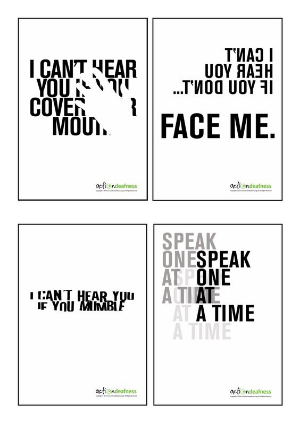Day Four - Communicating With Someone Who is Deaf or Hard of Hearing

Did you know?
People who are deaf or hard of hearing may use hearing aids or cochlear implants to amplify or have increased access to sound. Yet, in normal, every day environments it can remain a challenge for someone who is hard of hearing to have a conversation. Here are some tips for communicating with someone who is deaf or hard of hearing. Bonus, these are great communication tools to use with anyone, all the time!
- Gain the Person's Attention - call someone by their name, or gently tap on the shoulder to ensure you have their attention. If you know someone hear's better from one ear, try to be on that side to make it easier for him or her to hear you.
- Maintain Eye Contact - facial expressions and body language are important visual cues to help get your message across.
- Keep Hands Away from Face - putting your hand over your mouth can make it very challenging for someone who also lip reads to understand what you are saying. Avoid turning your head away to attend to something else while you are speaking.
- Be Mindful of Background Noise - if there is background noise, try to move away from the source. If that's not possible, ensure that you are following the steps above and speak clearly.
- Ask for Clarification - if you are unsure if the person who are speaking to is understanding what you say, if its appropriate, ask them to repeat what you've said so that you can help clear up any misinterpretation if there is any.
- Never Say "Never Mind" - if a person who is deaf or hard of hearing has trouble hearing you and asks you to repeat yourself, keep in mind they are not asking to be annoying. They simply want to understand what you said. Avoid saying "never mind" or "I'll tell you later". It can be alienating for someone to think that you will not take the time to repeat yourself.
Today's Challenge
In the spirit of being inclusive, try playing a game of musical chairs two ways.
- Play musical chairs the traditional way, by having one less chair than the number of people playing each round. Every time the music stops, whoever does not have a chair will be out.
- Then play musical chairs without removing a chair. Play the music and have everyone sit down when the music stops.
Afterwards, discuss what it felt like if you were out when the music stopped.
Then, discuss what it was like when no one was out, and you knew everyone would have a chair together.
The lesson here? When speaking to someone who is deaf or hard of hearing, making the effort to ensure that he or she understands you is a great way for him or her to feel included.
In the News
A Tennessee kindergarten class gives the school's custodian a birthday surprise he may never forget when they learn to sing happy birthday to him using sign language.





